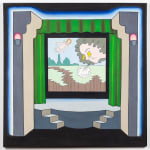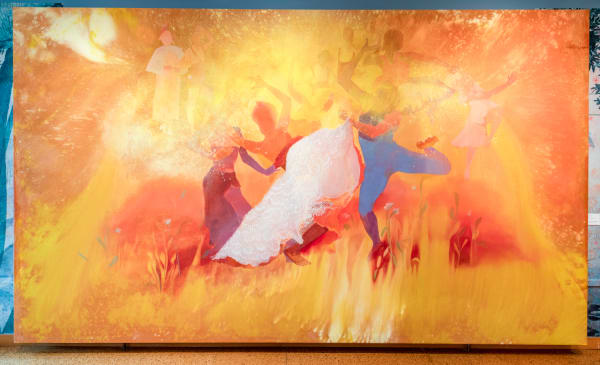274.3 x 487.7 cm
Roger Brown
Theatre, 1968
Oil on canvas
60 x 61 x 2 in
152.4 x 154.9 x 5.1 cm
152.4 x 154.9 x 5.1 cm
4843
Further images
-
(View a larger image of thumbnail 1
)

-
(View a larger image of thumbnail 2
)

-
(View a larger image of thumbnail 3
)

-
(View a larger image of thumbnail 4
)

-
(View a larger image of thumbnail 5
)

-
(View a larger image of thumbnail 6
)

-
(View a larger image of thumbnail 7
)

-
(View a larger image of thumbnail 8
)

Brown’s interest in theater was as much conceptual as it was aesthetic. Committed to the illusionary potential of painting, he extensively studied the topic of presentation and forced perspective. The...
Brown’s interest in theater was as much conceptual as it was aesthetic. Committed to the illusionary potential of painting, he extensively studied the topic of presentation and forced perspective. The three-point relationship between viewer, object, and backdrop recurs constantly throughout his entire practice, from his earliest paintings in school all the way through the end of his life, the syntactical logic of theater spaces making that most evident in these earliest works.
Moody but elusive in their actual narrative, Brown’s theater paintings recall the surreal vacancy of Magritte, while feeling in conversation with some of the semiotic and epistemological explorations of theater by continental philosophers of the day. As Brown’s practice would evolve, the most common nod back to this structure would be his iconic silhouettes: darkened figures framed in glowing yellow windows or moody cloud cover. Towards the end of his life, he became especially interested in bringing the metaphor into the third dimension, projecting shelves from the bottoms of his paintings so that sculptural objects could sit directly in front of paintings, explored most throughly in his series “Virtual Still Lifes.”
This interrogation of forced perspective relates to Brown’s larger interest in artificiality and the relationship between real and unreal. The transformative potential of illusion could be spiritually liberating or culturally destructive in Brown’s eyes, a precarious tension which required careful thought and reflection. In one particularly acerbic moment, Brown produced a painting in 1988 that characterized Disney’s EPCOT Center as “a funeral for real experience.”
Moody but elusive in their actual narrative, Brown’s theater paintings recall the surreal vacancy of Magritte, while feeling in conversation with some of the semiotic and epistemological explorations of theater by continental philosophers of the day. As Brown’s practice would evolve, the most common nod back to this structure would be his iconic silhouettes: darkened figures framed in glowing yellow windows or moody cloud cover. Towards the end of his life, he became especially interested in bringing the metaphor into the third dimension, projecting shelves from the bottoms of his paintings so that sculptural objects could sit directly in front of paintings, explored most throughly in his series “Virtual Still Lifes.”
This interrogation of forced perspective relates to Brown’s larger interest in artificiality and the relationship between real and unreal. The transformative potential of illusion could be spiritually liberating or culturally destructive in Brown’s eyes, a precarious tension which required careful thought and reflection. In one particularly acerbic moment, Brown produced a painting in 1988 that characterized Disney’s EPCOT Center as “a funeral for real experience.”
Provenance
Artist Studio, ChicagoPhyllis Kind Gallery, Chicago
Roger Brown Study Collection, Chicago
Kavi Gupta, Chicago
Exhibitions
2009, Roger Brown: Early Work, Major Paintings and Constructions 1968 - 1980, Russell Bowman Art Advisory2016, Gist and Gesture, Kavi Gupta
2018, Famous Artists From Chicago 1965 - 1975, Fondazione Prada Milan, curated by Germano Celant
Share
- X
- Tumblr
Contact: +1 708-480-2882
General Inquiries: info@kavigupta.com
Media Inquiries: media@kavigupta.com
Client & Sales Inquiries: client@kavigupta.com
Publications: Kavi Gupta Editions
835 W. Washington Blvd. Fl 1-3 Chicago, IL 60607
Hours | Tue–Fri: 11 am–6 pm, Sat: 12 pm–5 pm
835 W. Washington Blvd. Fl 2 Chicago, IL 60607
Hours | Tue–Fri: 11 am–6 pm, Sat: 12 pm–5 pm
2025 Kavi Gupta
This website uses cookies
This site uses cookies to help make it more useful to you. Please contact us to find out more about our Cookie Policy.








